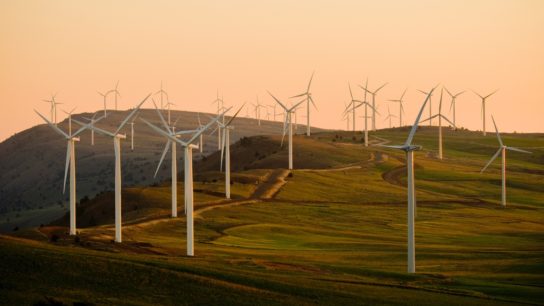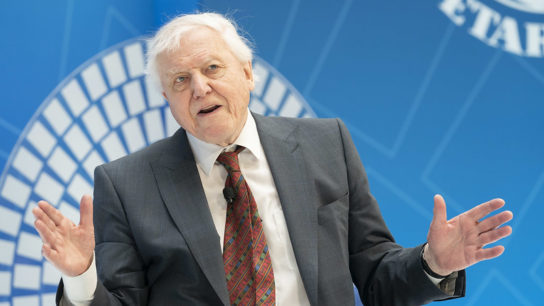Blended finance has emerged as a promising solution to unlock the trillions needed for a net-zero economy, combining public, philanthropic and private money to support sustainable projects. However, despite growing interest, experts warn that current funding levels fall far short of what’s required to combat climate change. How does blended finance work and how can it meet the urgent need for climate action?
—
Business experts at this year’s climate summit in Hong Kong have called for “blended finance” to be used to secure the trillions of dollars needed to move to a net-zero economy as temperatures on planet Earth repeatedly break heat records.
Blended finance happens when philanthropists or governments pay for or offer incentives to encourage private investors to put money in sustainable deals or projects that are not seen as “bankable,” where risks are high and returns low.
This mix of financing can kickstart climate projects in developing nations that would otherwise be deemed too risky for private investors, especially early on. During the One Earth Summit in March, En Lee, Managing Director of Sustainable and Impact Investments in Asia for LGT, emphasized its importance in attracting larger investors.
“All the deals we did in the early days usually involved the philanthropist coming in, putting in some capital to de-risk the proposition, and then a bank like the World Bank coming on board,” Lee said. “You have to lever it as blended finance to bring in bigger players.”
Trillions Needed
Experts estimate that to get to net zero emissions and meet the Paris Agreement climate goals, spending on clean energy will need to go from US$1.8 trillion in 2023 to US$4.5 trillion annually by the early 2030s. In Asia alone, the cost could jump to US$71 trillion to achieve net zero by 2050, according to the Asia Investor Group on Climate Change.
Blended finance makes up part of the broader climate finance landscape, which tripled during the past decade to almost $1.3 trillion in 2022, according to nonprofit Climate Policy Initiative.

While the idea of blended finance originated in 2015 to support the UN’s Sustainable Development Goals, interest has surged recently due to the urgent need to decarbonise a warming Earth already facing stressed planetary boundaries.
This mix of financing can channel funds to projects that enhance resilience and protect vulnerable communities from climate change, focusing on both infrastructure and social impacts, especially in developing countries.
Non-profit global network Convergence reports that blended finance rebounded in 2023, reaching a 5-year-high of $15 billion, with funding of climate projects doubling in a year.

At the One Earth summit, Lee told attendees about M-KOPA, an example of a blended finance project. M-KOPA is a pay-as-you-go provider of solar home systems that caters to low-income, off-grid customers in Sub-Saharan Africa.
The company enabled underbanked African customers who once relied on kerosene to use mobile credit to pay for solar power, enabling them to own their home systems after 12 to 18 months, said Lee.
Now M-KOPA powers homes in nations like Kenya and Uganda, deploying $1 billion to more than 4 million customers. This has slashed reliance on fossil fuels while improving access to education, healthcare and technology.
Getting the Flywheel Moving
M-KOPA exemplifies the climate opportunities available, enabling millions to take part in the modern economy as the cost of renewables like wind and solar falls, making it more attractive for investors.
Business begins to act when the numbers work, TPG Capital Founding Partner Jim Coulter said at the summit, adding the world is about to see “one of the most fascinating periods of business and economic history.”
Over the past year, several global groups have committed to blended finance. At the 2023 UN climate conference in Dubai, the Green Climate Fund and Allianz Global Investors pledged $5 billion.
Asia is particularly important, accounting for around half of global emissions. Singapore has launched the FAST-P blended finance platform, aiming to raise US$5 billion for climate action in the region, while Hong Kong is pushing itself as a green finance hub to support climate initiatives.
Still, these sums fall short of the trillions needed every year to decarbonise. Since 2015, Convergence has recorded 1,233 blended transactions totalling $231 billion.
“To really achieve net zero, we know that the private and public sector will need at least $3.8 trillion dollars annually between now and 2025,” Deepali Khanna, Vice President of the Asia regional office of the Rockefeller Foundation, told the One Earth summit. “We are not even close to a fraction of the dollars coming through.”
The market has struggled to combat climate change due to several factors, according to Prince Max von und zu Liechtenstein, Chairman of LGT Private Banking. Improper pricing of carbon emissions and conserving nature, low accountability for widespread emissions, resistance from the fossil fuel industry, and high upfront costs of switching to cleaner energy were all hurdles, he explained.
The prince called for a shift in mindset, a view echoed by TPG’s Coulter, who told summit attendees that the flip side of the climate crisis is the “massive opportunity” for society and investors to rebuild global supply chains.
“Opportunity is what will get the flywheel moving,” said Coulter, who has set up a climate fund called TPG Rise Climate, part of the company’s $19 billion impact platform.
Experts at the summits said philanthropists can leverage these opportunities to invest in projects that offer innovative climate solutions and connect start-ups with purpose-driven investors, attracting companies and governments. “What really is exciting for me is to see the intersections around people and the planet,” said Khanna.
Already some of the world’s biggest charities, including the Bezos Earth Fund, have teamed up with the World’s Bank’s investment arm to try to generate $11 billion in climate cash in emerging economies. The platform, Allied Climate Partners, aims to raise US$825 million to attract more private money than any previous blended finance initiative.
To succeed, projects must grow bigger, and players must embrace the risks, profits and impacts of blended finance, experts at the summit said. Establishing standardised and transparent measurements for outcomes and impacts is essential.
Governments are vital in enabling blended finance through supportive policies and laws. They need to help address regulatory hurdles and improve information sharing among data providers, Convergence said in an April 2024 brief.
As the planet approaches critical climate thresholds, experts at the summit all agreed on the need to collaborate.
“Public, private, philanthropic partnerships are definitely the way to go,” said Khanna. “With the difficult problems we’re trying to solve, none of us can really achieve them alone.”
This story is funded by readers like you
Our non-profit newsroom provides climate coverage free of charge and advertising. Your one-off or monthly donations play a crucial role in supporting our operations, expanding our reach, and maintaining our editorial independence.
About EO | Mission Statement | Impact & Reach | Write for us














